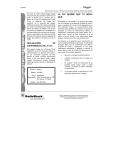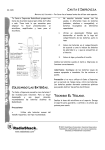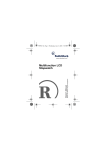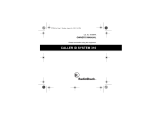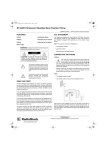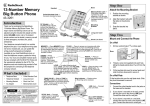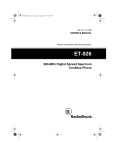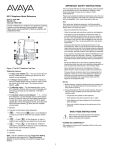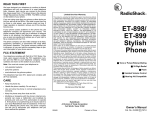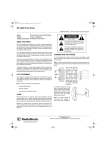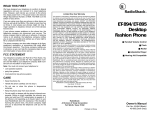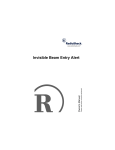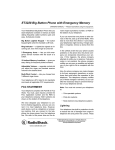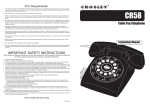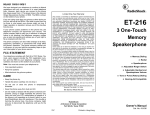Download Radio Shack ET 3229 User's Manual
Transcript
ET 3229 Big Button Speakerphone OWNER’S MANUAL — Please read before using this equipment. Your RadioShack Big Button Speakerphone lets you store up to 13 frequently called telephone numbers in memory for quick, easy dialing of any stored number. Its features include: Big Button Keypad — provides easy button recognition. Built-in Speakerphone — gives you handsfree operation. 13 Memory Locations — allows quick, easy dialing of frequently called numbers. Ring Indicator — a lighted bar signals an incoming call even if the ringer is turned off. Adjustable Ringer and Receiver Volume — lets you adjust the ringer and receiver’s volume to the desired level. Your telephone is ETL listed to UL standards and meets all applicable FCC requirements. FCC STATEMENT We have designed your telephone to conform to federal regulations, and you can connect it to most telephone lines. However, each device that you connect to the telephone line draws power from the line. We refer to this power draw as the phone’s ringer equivalence number (REN). The REN is on the bottom of your phone. If you use more than one phone or other device on the line, add up all the RENs. If the total is more than five (three in rural areas), your phone might not ring. If the ringer operation is impaired, remove one of the devices from the line. In the unlikely event your phone causes problems on the phone line, the telephone company can disconnect your service. The phone company tries to notify you in advance. If advance notice is not practical, the telephone company notifies you as soon as possible and advises you of your right to file a complaint with FCC. Your telephone complies with Part 68 of FCC Rules, you must, upon request, provide the FCC registration numbers and the REN to your telephone company. Both numbers are shown on the bottom of the telephone. This device complies with Part 15 of the FCC Rules. Operation is subject to the following two conditions: (1) this device may not cause harmful interference, and (2) this device must accept any interference received, including interference that may cause undesired operation. Note: You must not connect your telephone to: • Coin-operated systems • Party-line systems • Most electronic key telephone systems Lightning Your telephone has built-in protection circuits to reduce the risk of damage from surges in (telephone and power) line current. These protection circuits meet or exceed the FCC requirements. However, lightning striking the telephone or power lines can damage your telephone. © 2001 RadioShack Corporation. All Rights Reserved. RadioShack and RadioShack.com are trademarks used by RadioShack Corporation. Lightning damage is not common. Nevertheless, if you live in an area that has frequent electrical storms, we suggest you unplug your telephone when storms approach to reduce the possibility of damage. have the telephone company update the wiring for you. You must use compatible modular jacks that are compliant with Part 68 of FCC Rules. Note: The USOC number of the jack to be installed is RJ11C (or RJ11W for a wall plate jack). WARNING: To reduce the risk of fire or shock hazard, do not expose this product to rain or moisture. Mounting the Phone CAUTION RISK OF ELECTRIC SHOCK. DO NOT OPEN. You can mount your telephone on a wall plate, directly on a wall, or place it on a shelf, desk or table. ! CAUTION: TO REDUCE THE RISK OF On a Desktop ELECTRIC SHOCK, DO NOT REMOVE COVER OR BACK. NO USER-SERVICEABLE PARTS INSIDE. REFER SERVICING TO QUALIFIED PERSONNEL. Use the supplied mounting bracket as a stand when you place the phone on a desk, shelf, or table. This symbol is intended to alert you to the presence of uninsulated dangerous voltage within the product’s enclosure that might be of sufficient magnitude to constitute a risk of electric shock. Do not open the product’s case. ! 1. Insert the mounting bracket’s two smaller tabs into the matching slots near the keyhole slot on the underside of the phone’s base. Then press down on the bracket until its larger tabs snap into place. 2. Plug one end of the supplied long modular cord into the LINE jack at the back of the base. This symbol is intended to inform you that important operating and maintenance instructions are included in the literature accompanying this product. 3. Plug the cord’s other end into a modular phone line jack. On a Wall Plate or Wall PREPARATION 1. Insert the mounting bracket’s two smaller tabs into the matching slots opposite the keyhole slot on the underside of the phone’s base. Then press down on the bracket until its two larger tabs snap into place. Selecting a Location Select a location for your telephone that is: • Near a telephone jack 2. Plug one end of the supplied short modular cord into the LINE jack at the back of the base. Route the modular cord through the strain relief channel. • Not in the way of normal activities in the area Your telephone connects directly to a modular telephone line jack. If your telephone wiring does not have a modular jack, you can update the wiring yourself using jacks and adapters (available at your local RadioShack store), or 3. Plug the cord’s other end into the wall plate jack, then align the base’s keyhole 2 slots with the wall plate studs and slide the phone downward to secure it. meet these specifications could damage the telephone or the adapter. 4. Press and lift up the handset holder, rotate it 180°, then snap it back so it holds the handset. • Always connect the AC adapter to the telephone before you connect it to AC power. When you finish, disconnect the adapter from AC power before you disconnect it from the telephone. To mount the phone directly on a wall, in addition to the preceding steps, you need two screws (not supplied) with heads that fit into the keyhole slots on the bottom of the base. Plug the barrel plug of the supplied adapter into the DC 9V jack at the back of the telephone. Plug the other end into a nearby AC outlet. Drill two holes 315/16 inches (100 mm) apart. Then thread a screw into each hole, letting the heads extend about 5/16 inches (8mm) from the wall. Setting the Ringer If you do not want to hear the phone ring, set RINGER to OFF. You can still make calls with the ringer off, and you can answer calls if you hear another phone on the same phone line ring. The bar-shaped ring indicator flashes when the phone rings, even when the ringer is off. If you want to hear the phone ring, set RINGER to HI or LO. Substitute the long modular cord for the short cord mentioned in step 2. Connecting the Handset Plug one end of the coiled cord into the modular jack on the handset. Then connect it to the jack on the left side of the telephone base. Setting the Dialing Mode Note: Your local RadioShack store sells a variety of longer coiled handset cords, which are especially useful when you mount the phone on a wall. Set T/P (TONE/PULSE) for the type of service you have. If you are not sure which type you have, do this simple test. Connecting an AC Adapter 1. Set T/P to T. Lift the handset and listen for a dial tone. Your telephone operates from telephone line power. In some areas, however, the telephone might not provide enough power to operate all of your telephone’s features. If the volume of the speaker is too low, even with the volume control set to its highest level, or if the speaker does not work, you need to connect the supplied AC adapter. 2. Press any number except 0. If your phone requires that you dial an access code (9, for example) before you dial an outside number, do not press the access code number either. If the dial tone stops, you have touchtone service. Leave the setting to T. Cautions: If the dial tone continues, you have pulse service. Set T/P to P. You must use a Class 2 power source that supplies 9V DC and delivers at least 200 mA. Its center tip must be set to positive and its plug must fit the telephone's DC 9V jack. The supplied adapter meets these specifications. Using an adapter that does not ! 3 OPERATION 2. Enter the telephone number, then press STORE again. Using the Speakerphone 3. Press the direct memory location (1-3) at the top of the phone or the desired standard memory location (0-9) using the standard keypad. You can use the built-in speakerphone instead of the handset. When you press SPEAKERPHONE, the indicator lights and the phone connects the telephone line. To disconnect the telephone line, press SPEAKERPHONE again. The indicator goes off. Notes: If you are using the handset and you want to switch to the speakerphone, press SPEAKERPHONE. Return the handset to the cradle. • Since pressing STORE does not break the dial tone, the phone company “line alert” signal may occur when entering longer numbers. This does not affect number storage. To switch from the speakerphone to the handset, lift the handset. When you lift up the handset, the speakerphone turns off automatically. • To replace a number in one of the memory locations repeat steps 1 through 3. During step 2, enter the new number in any memory location you wish to change. If you decide to change from speakerphone to handset operation during redial or memory dialing, let the number completely dial before you lift the handset. Dialing a Stored Number To dial a number stored in direct memory, press the desired direct memory location (1-3) at the top of the phone. Setting the Receiver and Speakerphone Volume To dial a number stored in a standard memory location, press MEMORY, then the desired memory key (0-9). Slide RECEIVER VOL to LO/MED/HI as desired to adjust the handset receiver volume. Chain-Dialing Memory Numbers Slide SPEAKER VOL to set the speakerphone volume as desired. If you frequently use special telephone services, you can save time by storing the phone number of the service in one memory location and the rest of the information, such as a long distance number, in another memory location. Using Mute To temporarily disconnect the speakerphone or handset without ending the call, so you can talk privately with someone in the room, press MUTE. The MUTE indicator lights. To resume your call, press MUTE. The MUTE indicator goes off. To chain-dial, enter the memory location of the service number first. Then when the service answers, enter the memory location of the other information. Note: We recommend you do not store security numbers, such as personal access codes for bank-by-phone services, in any memory location. Storing a Number in Memory The telephone has 3 direct and 10 standard phone memory storage locations. 1. With the handset off hook or SPEAKERPHONE on, press STORE. 4 Using Redial You can quickly dial the last number dialed by pressing REDIAL/PAUSE when you hear a dial tone. The redial number is replaced each time you dial a new number. The redial memory holds up to 32 digits, to store long distance as well as local numbers. Note: If you press FLASH while dialing a number, only the digits after FLASH are stored in redial memory. Using Flash Many special telephone services, such as Call Waiting, require a switchhook signal. The FLASH button provides the electronic equivalent of a switchhook operation. For example, if you have Call Waiting, you can put a call on hold and take a second incoming call on the same line by pressing FLASH. Only the digits you dial after you press FLASH are stored in redial memory. Note: If you do not have any special phone services, pressing FLASH might disconnect the current call. Using Pause In some telephone systems, you must dial an access code (9, for example) and wait for a second dial tone before dialing an outside number. When you manually dial a number, or when you store a number in memory, you can have your telephone pause anywhere during the dialing sequence. Simply press REDIAL/ PAUSE at the desired location. When you redial or memory dial a number, the telephone pauses for about 3 to 6 seconds at the pause entry. For longer pauses, press REDIAL/PAUSE again. 5 Modifying or tampering with the telephone’s internal components can cause a malfunction and might invalidate its warranty and void your FCC authorization to operate it. If your telephone is not performing as it should, take it to your local RadioShack store for assistance. If the trouble is affecting the telephone lines, the phone company can ask you to disconnect your telephone until you have resolved the problem. TROUBLESHOOTING If your telephone is not operating properly, go through this checklist. Is the phone properly connected? Is the T/P switch set correctly? If the telephone’s volume level drops or it begins to make strange sounds, determine if other phones have been picked up on the same line. This phone might not operate when other phones are active on the same line (especially in areas with low telephone voltage). Hang up the other phones to correct the problem. If any additional telephone devices have been added at or about the time this phone’s performance diminished, recalculate the total REN for your devices (see “FCC STATEMENT” on Page 1). If the volume of the speaker is too low, even with the volume control set to its highest level, or if the speaker does not work, connect the supplied AC adapter (see “Connecting an AC Adapter” on Page 3). When the party on the phone cannot hear you, but you can hear them, check the MUTE indicator. If the light is on, press MUTE so it is off. If you still have problems, disconnect the phone. If other phones on the same line work properly, the fault is in this phone or its installation. If you cannot find the problem, take your phone to your local RadioShack store for assistance. CARE Keep the telephone dry; if it gets wet, wipe it dry immediately. Use and store the telephone only in normal temperature environments. Handle the telephone carefully; do not drop it. Keep the telephone away from dust and dirt, and wipe it with a damp cloth occasionally to keep it looking new. 6 A QUICK LOOK AT YOUR PHONE DIRECT MEMORY (see “Storing a Number in Memory” and “Dialing a Stored Number” on Page 4). RING INDICATOR BAR MEMORY (see “Dialing a Stored Number” on Page 4). STORE (see “Storing a Number in Memory” on Page 4). MUTE (see “Using Mute” on Page 4). FLASH (see “Using Flash” on Page 5). REDIAL/PAUSE (see “Using Redial” on Page 5 and “Using Pause” on Page 5). SPEAKERPHONE (see “Using the Speakerphone” on Page 4). RECEIVER volume control for adjusting the volume of the handset receiver (see “OPERATION” on Page 4). DC 9V jack for connecting an optional AC adapter (see “Connecting an AC Adapter” on Page 3). Control for adjusting the SPEAKERPHONE volume. LINE jack RINGER switch for adjusting ringer volume (see “Setting the Ringer” on Page 3). T/P switch for setting the Dialing Mode (see “Setting the Dialing Mode” on Page 3). 7 Limited One-Year Warranty This product is warranted by RadioShack against manufacturing defects in material and workmanship under normal use for one (1) year from the date of purchase from RadioShack company-owned stores and authorized RadioShack franchisees and dealers. EXCEPT AS PROVIDED HEREIN, RadioShack MAKES NO EXPRESS WARRANTIES AND ANY IMPLIED WARRANTIES, INCLUDING THOSE OF MERCHANTABILITY AND FITNESS FOR A PARTICULAR PURPOSE, ARE LIMITED IN DURATION TO THE DURATION OF THE WRITTEN LIMITED WARRANTIES CONTAINED HEREIN. EXCEPT AS PROVIDED HEREIN, RadioShack SHALL HAVE NO LIABILITY OR RESPONSIBILITY TO CUSTOMER OR ANY OTHER PERSON OR ENTITY WITH RESPECT TO ANY LIABILITY, LOSS OR DAMAGE CAUSED DIRECTLY OR INDIRECTLY BY USE OR PERFORMANCE OF THE PRODUCT OR ARISING OUT OF ANY BREACH OF THIS WARRANTY, INCLUDING, BUT NOT LIMITED TO, ANY DAMAGES RESULTING FROM INCONVENIENCE, LOSS OF TIME, DATA, PROPERTY, REVENUE, OR PROFIT OR ANY INDIRECT, SPECIAL, INCIDENTAL, OR CONSEQUENTIAL DAMAGES, EVEN IF RadioShack HAS BEEN ADVISED OF THE POSSIBILITY OF SUCH DAMAGES. Some states do not allow limitations on how long an implied warranty lasts or the exclusion or limitation of incidental or consequential damages, so the above limitations or exclusions may not apply to you. In the event of a product defect during the warranty period, take the product and the RadioShack sales receipt as proof of purchase date to any RadioShack store. RadioShack will, at its option, unless otherwise provided by law: (a) correct the defect by product repair without charge for parts and labor; (b) replace the product with one of the same or similar design; or (c) refund the purchase price. All replaced parts and products, and products on which a refund is made, become the property of RadioShack. New or reconditioned parts and products may be used in the performance of warranty service. Repaired or replaced parts and products are warranted for the remainder of the original warranty period. You will be charged for repair or replacement of the product made after the expiration of the warranty period. This warranty does not cover: (a) damage or failure caused by or attributable to acts of God, abuse, accident, misuse, improper or abnormal usage, failure to follow instructions, improper installation or maintenance, alteration, lightning or other incidence of excess voltage or current; (b) any repairs other than those provided by a RadioShack Authorized Service Facility; (c) consumables such as fuses or batteries; (d) cosmetic damage; (e) transportation, shipping or insurance costs; or (f) costs of product removal, installation, set-up service adjustment or reinstallation. This warranty gives you specific legal rights, and you may also have other rights which vary from state to state. RadioShack Customer Relations, 200 Taylor Street, 6th Floor, Fort Worth, TX 76102 We Service What We Sell RadioShack Corporation Fort Worth, Texas 76102 12/99 43-3229 06A01 Printed in China








